Manual for
URBAN FREE HABITAT
 URBAN FREE HABIAT SYSTEM, Copenhagen 2008
URBAN FREE HABIAT SYSTEM, Copenhagen 2008
Introduction:
The URBAN FREE HABITAT SYSTEM defines a 3D space for any person to use.
It may be placed in various parts of a city to provide persons with a
place to relax, eat, sleep, etc.
The URBAN FREE HABITAT SYSTEM is a low cost system that could easily be
initiated and implemented by local communities
Once moored at a site in a city, the URBAN FREE HABITAT SYSTEM can be
customized by the community to suggest a specific use. For example, it
could be designated as a Caravanserai (a traditional Eastern inn for travelers),
a meeting place for locals, or a noncommercial café and kitchen.
The structure can also be customized to meet local needs or weather conditions.
Though the basic version shown on this page does not protect the users
from rain, the structure could easily be covered with a tarp. The entire
sphere could be insulated or insulated structures could be built and suspended
within the frame to provide comfort in cold climates.
URBAN FREE HABITAT SYSTEM can be moved to a new site by one person, simply
by rolling it like a ball. It can scale up or down and be used both inside
existing buildings and outdoors. In areas with a high concentration of
human activity, clusters of URBAN FREE HABITAT SYSTEM might be needed.

Background:
Traditional urban planning aims to inject cities with places for housing
and culture of a predefined type. Little power is given to the residents
to make decisions about their own environment. Consequently, the public
space in most western cities and the urban landscape as such is dominated
by concentrations of power and their commercial interests. All human needs
are hijacked to make a profit. N55 propose the implementation of systems that would allow persons to design
the public
places they inhabit and share these places with others, regardless of
anyone’s financial situation. Using such systems, people would be
able to create free places to stay and meet, cook and eat, etc, where
they are most needed. The URBAN FREE HABITAT SYSTEM is a result of a workshop
by N55 at the Metropolis Laboratory in Copenhagen.
Construction:
The main structure of the URBAN FREE HABITAT SYSTEM is a 3- frequency
version of a geodesic sphere. Geodesic spheres are highly efficient structures
that enclose maximum volume with minimal surface area and can be incredibly
strong and rigid using a minimal amount of material. The spherical surface
allows for this structure to be transported simply by rolling it, without
special machinery or excessive force. Geodesic structures were studied
and popularized by R. Buckminster Fuller in the late 1940’s. The
current 3.5 meter diameter URBAN FREE HABITAT has been built using solid
plain steel balls 4cm in diameter for hubs and 19mm diameter, 1mm wall
plain steel tubing for the struts. Because the hubs are small spheres,
the struts can be welded to them at the appropriate angles without a need
for separate prefabricated 5- and 6- way connectors. A 3-frequency sphere
requires three different strut lengths. The struts were measured and cut
by hand with a cutoff disk on an angle grinder. Flat polygons (regular
hexagons and pentagons) found within the geodesic structure were fabricated
by measuring the required angles with a protractor and welding them together
apart from the main structure.If the proper strut lengths and arrangement
of struts is used, only one geometry is ultimately possible, so the structure
self-compensates for errors in angle measurements as it progresses. Diagrams
for assembly and the proper ratio of strut lengths can be found from numerous
sources on the Web. The version of the URBAN FREE HABITAT SYSTEM shown
here has been equipped with a plant growing system, hammocks, cooking
facilities, a toilet and a lamp.
Extensions:
The URBAN FREE HABITAT SYSTEM could be used for numerous specific purposes,
as long as they are free for any person to use. For example, given the
specific needs in a specific situation, a version of
the URBAN FREE HABITAT SYSTEM equipped as a greenhouse for growing food
might be relevant. Other possibilities include a disco with a sound system,
a schoolhouse, or an exercise facility. The open
3D space within the main structure allows for easy reprogramming to temporarily
transform the system for other purposes. .
Technical specifications:
Basic module:
Diameter: 3.5 meters
Mass: 150kg
Component list:
210 meters steel tubing (19mm diameter, 1mm wall-thickness)
96 steel balls (4cm diameter)
Hammocks
Water tank
Polyethylene buckets
Rope
Stakes
Lamp

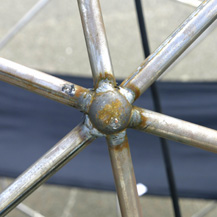
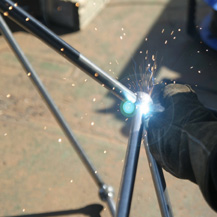
Aluminum version:
The URBAN FREE HABITAT SYSTEM can also be made from aluminum in a simple way as shown on the following photos.
A standard aluminum tube is cut at the correct length, hammered flat at the ends, bend at a tiny angle and a
hole is drilled at both ends. Assembling is easy with one single bolt connecting the struts at the joints.
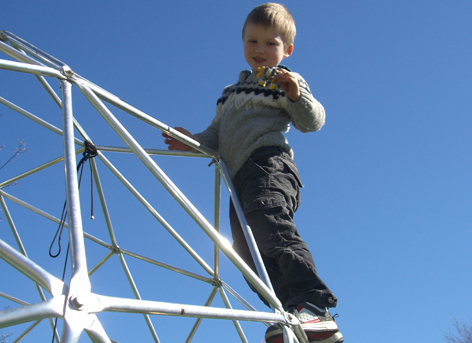
URBAN FREE HABITAT SITUATIONS:
 Antwerpen, Belgium, 2009.
Antwerpen, Belgium, 2009.
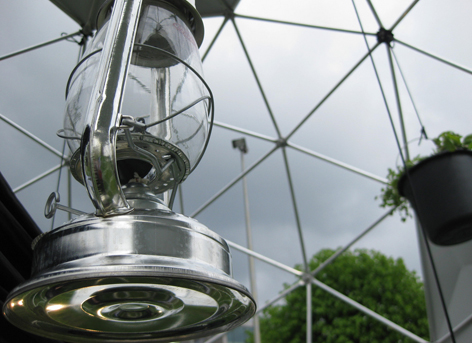

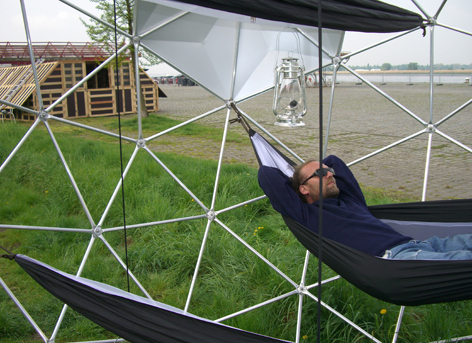
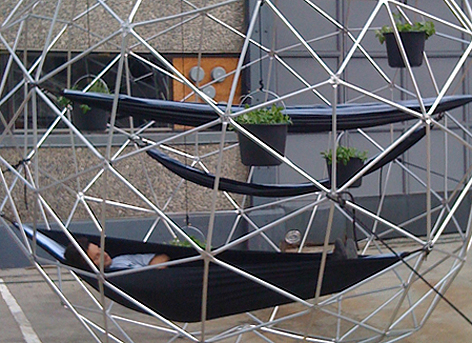 Showhow, Copenhagen, Denmark, 2009
Showhow, Copenhagen, Denmark, 2009
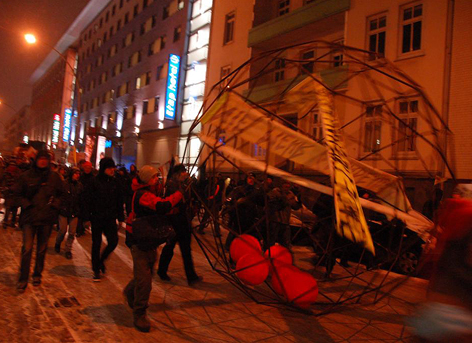 In 2009 the Subvision exhibition in Hamburg made a copy of the URBAN FREE HABITAT
In 2009 the Subvision exhibition in Hamburg made a copy of the URBAN FREE HABITAT
SYSTEM. After the end of the exhibition it was disposed of and found by till Wolfer and other
students at the HFBK. They restored it and used it as a DEMOTOOL in support of a squatted house.
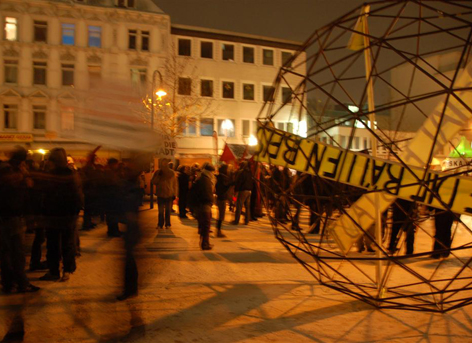
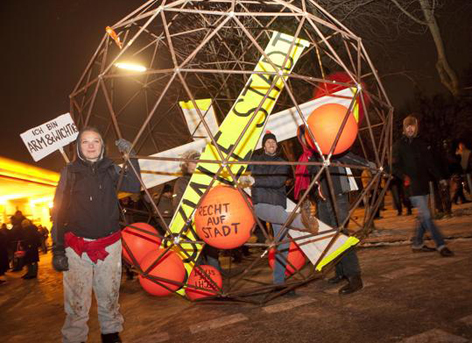
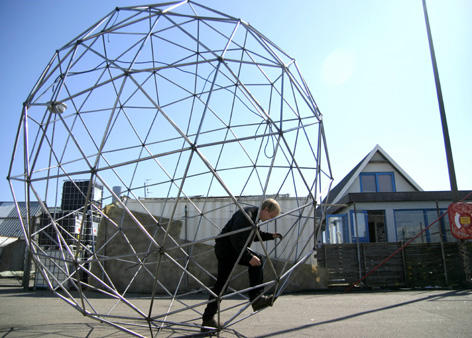 Peter madsen "Walking the structure".
Peter madsen "Walking the structure".
By N55
Thanks to Peter Madsen, Henry and HALFMACHINE
Realized in collaboration with Sam Kronick
Financed by Metropolis Lab Copenhagen 2008
Back to manuals
Back to HOME
 URBAN FREE HABIAT SYSTEM, Copenhagen 2008
URBAN FREE HABIAT SYSTEM, Copenhagen 2008












